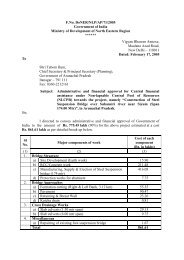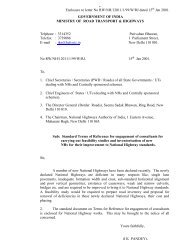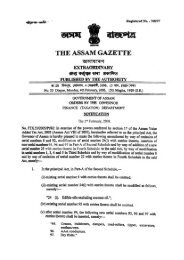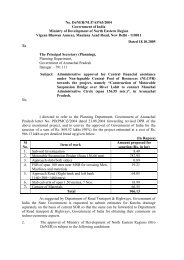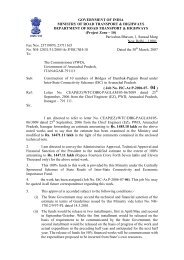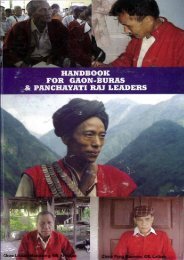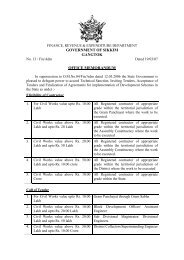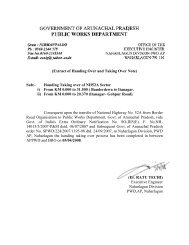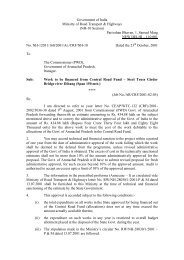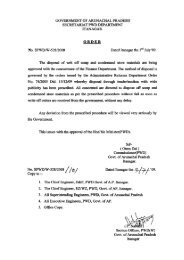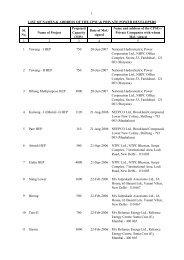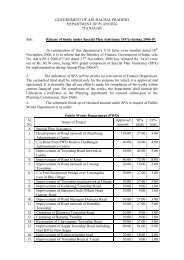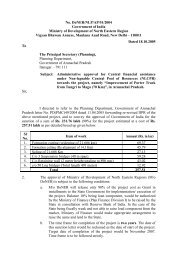TRAINING CIRCULAR - Arunachalpwd.org
TRAINING CIRCULAR - Arunachalpwd.org
TRAINING CIRCULAR - Arunachalpwd.org
Create successful ePaper yourself
Turn your PDF publications into a flip-book with our unique Google optimized e-Paper software.
GRAM : CHIEFWORKS<br />
e mail : boraete@gmail.com<br />
GOVT. OF ARUNACHAL PRADESH<br />
PUBLIC WORKS DEPARTMENT<br />
OFFICE OF THE CHIEF ENGINEER (EZ)<br />
PWD, ITANAGAR – 791 111<br />
No. CEAP(EZ)/E-I/9/07-08/5434-76 Dated, Itanagar the 18 th Oct/2007<br />
<strong>TRAINING</strong> <strong>CIRCULAR</strong><br />
Poor absorptive capacity of the State PWDs in NE Region has come under sharp focus<br />
of discussion in all major Central/Regional level summit (relevant docs are linked this page online<br />
in website). At home front too, policy makers of the State have expressed serious reservation<br />
in taking over of National Highway works by State PWD and more importantly, PWDs are kept<br />
away from participation of central programme like SARDP-NE and other major construction<br />
activities in the State.<br />
Issue needs immediate attention by all concerned. Senior level officers must attend<br />
training programmes in CRRI, Annual IRC Sessions, NITHE, IITs and elsewhere (letters from<br />
NITHE are linked to this page on-line). At the root level, workshops/training must be conducted at<br />
Circle Level on subjects like quality control, tendering, IRC code, on specifications/supervisions,<br />
use of gadgets like GPS, total station etc. Despite limitation of time and resource persons, in-house<br />
training efforts mostly on IT sector (AutoCAD, SAP-2000, MS-Office, MS Project, Web design<br />
etc.) were conducted in past at zonal level. The shift of attention should be now towards<br />
TENDERING and system improvement. Neighbouring Assam PWD has gone to the extent of etendering.<br />
To give brief exposure to various issues on tender matter, it has been decided that Shri<br />
Atop Lego, SSW (EZ) will under-take one-day training in Conference Hall (EZ office)/ Banquet<br />
on 07/11/2007. Target groups are Assistant Engineer (Plg)/ASWs, Junior Engineers and senior<br />
Draftsman in Planning Branch engaged in tender document preparation. Interested Superintending<br />
Engineers/ Executive Engineers are also requested to participate.<br />
In view of this each Superintending Engineer and Executive Engineer are directed to<br />
nominate ASW/AE (P) and one senior Draughtsman to attend the training so that they can be<br />
made responsible for preparation of tender document in future.<br />
(Bora Ete),<br />
Chief Engineer, (EZ)<br />
PWD, Itanagar.<br />
Copy for information to:<br />
1. The Commissioner (PWD), Govt. of Arunachal Pradesh, Itanagar for his kind<br />
information please.<br />
2. The Chief Engineer (D&P)/(S&I), PWD, Itanagar.<br />
3. The Chief Engineer (WZ) with request to depute as many participants as possible from<br />
The Circles/Divisions from Western Zone, PWD.<br />
4. Shri A. Lego, Superintending Surveyor of Works (EZ) for information.<br />
5. All Superintending Engineers/Executive Engineers (PWD) for information<br />
and needful action.<br />
Note:- This page uploaded at http://arunachalpwd.<strong>org</strong> alongwith attachments referred above.<br />
Chief Engineer, (EZ)
To<br />
Chief Engineer (EZ)<br />
Arunachal Pradesh PWD<br />
Itanagar – 791 111<br />
Arunachal Pradesh<br />
Subject: Training Calendar for the year 2007-2008 – Reminder for nominations.<br />
Sir,<br />
Please refer NITHE’s letters of even no. dated 01.03.2007 and 01.05.2007 on the<br />
subject. It may please be noted that participation from your Department in the training<br />
programmes <strong>org</strong>anized by NITHEs is very meager, yearwise details is enclosed. However,<br />
training requirements, at all the levels, has increased manifold especially after taking up large<br />
size Road Development Programmes by Central and State Govts. Training modules developed<br />
by the Institute are very useful to cater the growth needs of the sector which could be further<br />
tailored to fulfill your specific requirements, if any. Following training programmes shall be<br />
<strong>org</strong>anised in the next quarter:<br />
1. HDM-4 03-05 Oct<br />
2. Modern Trends in Design & Const of Bridges, Elevated Structures, Under<br />
Passes and Tunnels<br />
03-06 Oct<br />
3. Public Private Partnership in Highway Projects 08-12 Oct<br />
4. Computer Aided Highway Desing 10-12 Oct<br />
5. Refresher for Superintending Engineers 19-23 Nov<br />
6. Construction Supervision of Road & Bridge Projects 19-23 Nov<br />
7. Feasibility Study and DPR for Road Projects 26-01 Nov<br />
8. Design, Cont. & Maintenance of Rigid Pavement 28-30 Nov<br />
9. Foundation Corse for newly recruited Engineers (6 weeks) 17-25 Dec<br />
10. QC in Road and Bridge Works 10-14 Dec<br />
11. Design, Construction & Maintenance of Flexible Pavements 12-14 Dec<br />
12. Disaster Management in Highway Sector 18-20 Dec<br />
These programmes are residential and will be conducted at NITHE Campurs, Noida<br />
(UP). No course fee shall be charged for officers nominated by the M/o SRT&H and State<br />
PWDs, except lodging & boarding charges, if hostel facility is availed. The expenses towards<br />
TA/DA of the nominated officers shall be boned by the <strong>org</strong>anisation concerned. Besides regular<br />
programmes as per the calendar, special tailor-made training programmes are also <strong>org</strong>anized<br />
by NITHE on request, as per the specific requirements from the States. The expenditure<br />
incurred on such training is now an admissible item under the ‘quality control’ provisions of<br />
sanctioned NH works by the Ministry. You may like to consider sponsoring a few courses for the<br />
benefit of Engineers of your State in the coming financial year.<br />
Your are therefore requested kindly to ensure participation of 4-5 officers in each<br />
programme as per the calendar.<br />
Encl: As above.<br />
visit www.nithe.<strong>org</strong> for details
Sl.<br />
No.<br />
2<br />
Participation of Engineers in the Training Programme 2006-07<br />
Name of State Nos. 2002-03 2003-04 2004-05 2005-06 2006-07 Total<br />
A. State-wise<br />
1. Andhra Pradesh 172 1 0 4 4 90 271<br />
2. Arunachal Pradesh 37 0 1 4 17 29 79<br />
3. Assam 184 1 46 29 31 65 356<br />
4. Bihar 529 0 3 1 106 7 646<br />
5. Chhatisgarh 0 0 3 11 21 1 36<br />
6. Delhi 26 8 2 9 1 20 66<br />
7. Goa 5 12 94 0 0 19 130<br />
8. Gujarat 418 19 18 63 37 25 580<br />
9. Haryana 216 8 23 17 13 27 304<br />
10. Himachal Pradesh 168 6 0 27 193 34 428<br />
11. Jammu & Kashmir 90 0 9 16 5 3 123<br />
12. Jharkhand 0 3 4 18 0 7 32<br />
13. Karnataka 241 11 68 69 72 41 502<br />
14. Kerala 84 157 2 93 8 11 355<br />
15. Madhya Pradesh 186 6 8 57 23 75 355<br />
16. Maharashtra 464 0 38 75 15 95 687<br />
17. Manipur 12 0 3 1 0 0 26<br />
18. Meghalaya 14 0 0 9 5 23 51<br />
19. Mizoram 36 7 5 69 15 18 150<br />
20. Nagaland 8 0 7 0 0 5 20<br />
21. Orissa 50 1 0 230 90 48 419<br />
22. Punjab 158 19 1 18 168 26 390<br />
23. Rajasthan 450 10 12 28 21 42 563<br />
24. Sikkim 0 0 4 3 2 8 17<br />
25. Tamil Nadu 456 6 18 25 27 20 552<br />
26. Tripura 4 7 11 2 6 9 39<br />
27. Uttar Pradesh 374 73 201 79 54 35 816<br />
28. Uttaranchal 0 4 15 23 61 45 148<br />
29. West Bengal 348 4 9 7 0 40 408<br />
30. Chandigarh (UT) 5 0 0 0 0 1 6<br />
31. Pondicherry (UT) 2 4 0 0 2 0 8<br />
32. Andaman & Nicobar 0 0 1 2 0 0 3<br />
Total from State Govts 4737 367 606 989 997 870 8566<br />
Re-composed for http://arunachalpwd.<strong>org</strong>
NEC’s SECTORAL SUMMITS:<br />
A paradigm of shift to development<br />
of the North Eastern Region<br />
MINISTRY OF DEVELOPMENT OF NORTH EASTERN REGION<br />
GOVERNMENT OF INDIA
CONTENTS<br />
1. North-East Council : First Sectoral Summit<br />
― Pasighat Proclamation on Power (17 th January 2007) 1<br />
― First Sectoral Summit of NEC to review Power Sector 4<br />
Programmes in NE Region, Pasighat (16-17 th January, 2007<br />
Background, Issues & Conclusions<br />
2. ― Shillong Statement on Roads & Highways 8<br />
9 th February 2007<br />
3. ― 2 nd Sectoral Summit of NEC to review Road Sector 11<br />
programmes in the North Eastern Region<br />
held at Shillong on 8-9 th February 2007<br />
Background, Issues and Conclusions<br />
4. ― 4 th Sectoral Summit of the North Eastern Council to 18<br />
review Tourism and Hospitality sector programmes in<br />
North Eastern Region, New Delhi the 15-16 th November, 2006
1<br />
NORTH-EAST COUNCIL : FIRST SECTORAL SUMMIT<br />
Pasighat Proclamation on Power<br />
17 January 2007<br />
1. After viewing the presentations and listening to the interventions of all the<br />
principal CPSUs, Agencies, State Governments and Union Ministries<br />
involved, it would appear that there is need for a clear, coherent and<br />
consistent policy in respect of the power sector in the North-East Region,<br />
especially as the power sector constitutes the most important resource of<br />
the Region and holds the highest potential to propel the Region to the<br />
front rank of development in the country. With this overarching objective<br />
view, the following major elements have been identified which the<br />
Ministry of DoNER might pursue with the Union Government, NEC and<br />
States concerned to evolve the required clear, coherent and consistent<br />
policy for the development of the power sector in the North-East Region.<br />
2. The most important element of this proposed policy would be to reach the<br />
benefits of power availability to the people of the Region. As such, the<br />
thrust towards “Power to the People’’ requires prioritization.<br />
3. The second priority in respect of the development of the power sector in<br />
the North-East Region is to ensure that the growing and diversified<br />
demands for power for the economic development of the North-East<br />
Region are met in full.<br />
4. The third priority would be the export of power from the region to<br />
elsewhere in the country so that the North-East Region does in fact<br />
become the ‘'powerhouse” of the country.<br />
5. To achieve the first objective, namely, “Power to the People”, top priority<br />
attention requires to be paid to the Small Hydro Power Programme (SHP)<br />
for the NER, to be supplemented by other sources of new and renewable<br />
energy such as biomass and solar energy. It is evident that the existing<br />
structure of SHP is proving inadequate for accelerated implementation in<br />
NER, as evidenced, for instance, by the fact that out of 492 projects<br />
identified in Arunachal Pradesh, the NER state with the highest SHP<br />
potential, only 64 have been implemented, 48 are under construction, and<br />
thus as many as 380 out of 492 projects are still far from being<br />
implementable. At the same time, it is evident that households around the<br />
North-East, public thoroughfares including highways and trunk roads and<br />
other public places need to be lit up at night both for the people’s comfort<br />
and as a security measure. Yet, although 62% of villages are electrified,<br />
only 24% of households receive electricity. Therefore, the following<br />
inter-related policy measures appear to be required:<br />
a) Restructuring SHP for NER so that the level of subsidies ensures<br />
accelerated implementation of all identified SHP projects in NER
2<br />
which have been designed to generate over 2000 MW without<br />
complicated problems of transmission and distribution.<br />
b) Prioritizing NEC/ NLCPR lending to furnish viability gap funding<br />
for SHP projects.<br />
c) Ensuring sustainability of SHP projects through the involvement of<br />
elected representatives of the local community through Panchayati<br />
Raj Institutions/ Village Development Councils/ traditional bodies,<br />
as the case may be, in the management, repair and maintenance of<br />
SHP projects.<br />
d) It would appear that similar measures are required to popularize<br />
other MNRES programmes such as those relating to biomass and<br />
solar energy.<br />
6. With a view to ensuring the second priority, namely, the utilization of the<br />
power generated in NER for the accelerated industrial and economic<br />
development of the region itself, the following critical areas of attention<br />
have been identified:<br />
a) Prioritizing inter-State transmission within the region in the funding<br />
patterns of both the NLCPR administered by the Ministry of DoNER<br />
and the funds allocated to the NEC.<br />
b) Concerted attention by States, DoNER and NEC to funding subtransmission<br />
systems so that NER power is amply available for<br />
consumption within NER in all sections of the population and for all<br />
economic activities.<br />
c) Similarly, for distribution, besides prioritization in funding by<br />
States, DoNER and NEC, the Union Governments Accelerated<br />
Power Development and Reforms Programme (APDRP) also needs<br />
to be oriented towards implementation in NER.<br />
d) Consideration by the Union Government of a Centrally Sponsored<br />
Scheme to support inter-state and intra-state transmission and subtransmission<br />
projects.<br />
e) In view of the immense losses in transmission and distribution in<br />
NER, which are well above the national average, compounded by<br />
theft and other criminal activity which reduces availability to the<br />
consumers, special attention is required to be paid to managing the<br />
T&D system so that, through this most economical route, power<br />
availability to the consumer is expanded exponentially.<br />
7. To meet the third priority, namely, the conversion of NER into the<br />
‘powerhouse’ of the country, the critical requirement is to immediately do<br />
all that is required to ensure evacuation through the narrow window<br />
available in the Siliguri corridor (‘Chickens Neck’)<br />
8. Against an expected capacity addition of about 30,000 MW in the 10 th<br />
Plan, only about 225 MW is expected to come in the North East. Upto<br />
now, only about 125 MW has been added (i.e. 25 MW hydro (Kopili) and
3<br />
the rest thermal). Another hydro electric projects (Karbi Langpi, Assam)<br />
of capacity of 100 MW is expected in the next couple of months. A<br />
massive stepping up of public sector investment in power in the North-<br />
East in the Eleventh Plan is envisaged. But it is imperative that<br />
outstanding issues relating to the 2000 MW Lower Subansiri project be<br />
sorted out immediately by the Union Government in consultation with the<br />
State Governments of Arunachal Pradesh and Assam.<br />
9. All development projects in NER, but most particularly projects in the<br />
power sector, require massive infrastructure backing, especially roads to<br />
transport heavy equipment and helicopters to transport smaller size<br />
equipment, particularly for SHP. In the prioritization of roads and<br />
highway development in NER, and in the deployment of helicopters,<br />
power sector requirements need further prioritization.<br />
10. While, on an annual basis, NER has been a net exporter of power for the<br />
past several years, the fact that much of this exportable surplus comes<br />
from hydel sources means that there are times of the year in the lean<br />
season when NER needs to import power from the Eastern Grid.<br />
Therefore, in recognition of the contribution which NER is making to the<br />
Eastern Grid, particularly from Sikkim, reciprocal arrangements need to<br />
be put in place for the Eastern Grid to feed NER as and when required.<br />
11. While NER would be the primary source of hydel power for NER itself<br />
and the country as a whole, due recognition needs to be accorded to the<br />
availability of thermal sources of energy, including coal, shale and natural<br />
gas, in the NER, the exploitation of all of which falls at present far below<br />
the potential. A coherent policy of exploiting the thermal energy sources<br />
of the North-East needs to be put in place through coordination between<br />
the Ministries concerned of the Union Government and the State<br />
Governments.<br />
12. There can be little doubt that the future of the North-East rests upon its<br />
coming into its own through the power sector. It also needs to be<br />
recognized that the NER can make an invaluable contribution indefinitely<br />
to the country’s energy security through clean hydel energy. But this<br />
immense potential for the development of NER and the country cannot be<br />
realized until and unless special treatment is meted out to NER in the<br />
short term in the expectation and confidence that NER would reach the<br />
take-off stage in the medium term and NER would then become the frontrank<br />
Region for the development of the country as a whole in the long<br />
term. An enlightened, overall and long-term vision, therefore, needs to<br />
inform a clear, coherent and consistent power policy for the North East.<br />
**********
4<br />
FIRST SECTORAL SUMMIT OF NEC TO REVIEW POWER SECTOR<br />
PROGRAMMES IN THE NORTH EASTERN REGION, PASIGHAT (16–17<br />
JANUARY, 2007): BACKGROUND, ISSUES & CONCLUSIONS<br />
It was noted that a decision was taken at the 53 rd meeting of the North Eastern<br />
Council (NEC) held at New Delhi on 15 -16 November 2006 that sector<br />
specific meetings be <strong>org</strong>anized every month by rotation in the eight North<br />
Eastern States to review Central Sector / Centrally Sponsored Schemes(CSS)<br />
being implemented by Central Ministries in the North Eastern Region. A<br />
schedule of the first 16 meetings was drawn up. The first special meeting to<br />
review Power Sector programmes was held at Pasighat, Arunachal Pradesh.<br />
2. The power sector can broadly be divided into the following sub sectors :-<br />
(i) Generation – Hydel & Thermal<br />
(ii) Transmission & distribution (T&D)<br />
(iii) Rural Electrification (RGGVY)<br />
(iv) New & Renewable Energy (NRE)<br />
ISSUES :<br />
3. During the discussion following issues emerged :-<br />
(i) NER has vast Hydro Power potential which is estimated at about<br />
60,000 MW. Only about 2% has been tapped so far. Most of this<br />
potential lies in Arunachal Pradesh.<br />
(ii) There is an imbalance between Hydel & Thermal Power, both in<br />
terms of generation and availability.<br />
(iii) There has been a shortfall in generation against targets set for the<br />
10 th Plan period (2002-07). The likely slippages in capacity addition<br />
during 10 th Plan is 810MW. The total addition to generation capacity<br />
from 2002–03 to 31–10–2006 was 128.92 MW only. Another 100<br />
MW is expected to be added by 31-03–2007.<br />
(iv) It was informed that Sikkim is still included in the Eastern Power<br />
Grid and that NHPC’s Teesta Hydro– V (510 MW) will start<br />
generating power during 2007 – 08.<br />
(v) Ministry of Power/ NHPC assured that the 2000MW Lower<br />
Subansiri Hydro Project will be completed within the 11 th Plan<br />
period.<br />
(vi) Govt. of Arunachal Pradesh expressed their reservations regarding<br />
NHPC beginning work on the Lower Subansiri Hydro-Project<br />
without entering into an agreement with the State Govt.<br />
(vii) Govt. of Arunachal Pradesh requested that the Planning Commission<br />
and the Govt. of India assist the State Govt. to take up equity in the<br />
mega hydro projects proposed to be taken-up as joint ventures with<br />
CPSUs and IPPs.
5<br />
(viii) Ministry of Power informed that a review of the existing policy on<br />
hydro power development with participation of IPPs has been<br />
undertaken to provide for determination of tariffs by CERC on cost<br />
plus basis as compared to the existing tariff based basis.<br />
(ix) NHPC and NTPC requested for early completion of roads (specially<br />
NH 52) linking existing National Highways to the sites of major<br />
hydel power projects. It was suggested that some of these roads<br />
which are currently proposed to be undertaken under Phase-B of<br />
SARDP-NE may be included under Phase-A. They also requested<br />
for extension of the broad gauge railway network to provide railway<br />
connectivity to feasible locations near to the project sites. Specific<br />
reference was made to the proposed extension of BG railway line to<br />
Pasighat and Wakro in Arunachal Pradesh.<br />
(x) There have been inadequate investments in transmission and<br />
distribution grid. Four states, namely, Meghalaya, Manipur,<br />
Mizoram & Sikkim are connected by only 132 KV lines.<br />
(xi) PGCIL activities are at present restricted to inter-State Transmission<br />
systems only. Sub-transmission and Distribution has been taken-up<br />
mainly in the State sector with financial assistance from Ministry of<br />
DoNER and NEC.<br />
(xii) Ministry of Power provides assistance to the States for improving<br />
Distribution Systems under the Accelerated Power Development and<br />
Reforms Programme (APDRP). States requested continuation of the<br />
APDRP during the 11th Plan under existing guidelines and norms.<br />
(xiii) States expressed concern at levying of high wheeling charges @35<br />
paise per unit. It was noted that the Ministry of Power has referred<br />
the issue to the CERC.<br />
(xiv) Very high transmission and distribution losses (2004 – 05) ranging<br />
between 28.35% (Meghalaya) to 70.61% (Manipur) is another area<br />
of concern.<br />
(xv) Of the total 40,377 inhabited villages (2001 census), 25,248 (62%)<br />
have been electrified by October’ 2006. Only 24% of Rural<br />
Households have been electrified.<br />
(xvi) Rajiv Gandhi Grameen Vidyutikaran Yojana (RGGVY) introduced<br />
in April 2005 aims to provide electricity to all villages /habitations<br />
and Rural Households within 5 years. Target for 2006– 07 is 190<br />
villages.<br />
(xvii) Distributed generation feeding local grids or renewable energy<br />
schemes are ideal for providing power to small and scattered<br />
hamlets.<br />
(xviii) The current installed capacity as on 31-12-2006 is 2520.30MW<br />
(effective output about 1800 MW). The peak demand forecast by<br />
2011–12 is estimated at 2,620 MW & energy requirements at
6<br />
13,649MU. The installed capacity is proposed to be doubled by the<br />
end of the XIth Plan.<br />
CONCLUSIONS & RECOMMENDATIONS :-<br />
(i) A two pronged strategy to be adopted for power generation with focus on:<br />
a) Small/Localised Hydel & Thermal and NRE projects for catering to<br />
local needs.<br />
b) High capacity Hydel & Thermal Power Projects with associated<br />
Transmission lines for first meeting the demand for power of the<br />
North Eastern Region and thereafter that of the rest of the country.<br />
(ii) Ministry of Power to develop a clear, coherent and sustainable Power<br />
Policy for the NER which takes into account the special characteristics<br />
and needs of the Region.<br />
(iii) Ministry of Power has set-up a Task Force for preparing a Master Plan for<br />
Power Development in the North East Region. The Task Force should<br />
take note of the issues raised and conclusions arrived at this Sectoral<br />
Summit. The report should be finalized expeditiously and inputs included<br />
in the Ministry’s XIth Plan proposals.<br />
(iv) CEA to undertake feasibility studies for utilizing considerable shale<br />
deposits in Arunachal Pradesh and coal deposits in Assam and Meghalaya<br />
with the objective of increasing the share of thermal power.<br />
(v) ONGC & ILFS are in the process of setting up the 750 MW Palatana Gas<br />
Power Project in Tripura. Only Tripura and Assam have entered into<br />
MOU with ONGC / ILFS for purchase of power. Other power deficient<br />
States may also approach ONGC / ILFS for accessing power from the<br />
Palatana project.<br />
(vi) PGCIL to invest more in the trunk transmission lines for improving inter<br />
and intra-region connectivity. Adequate transmission system for<br />
evacuating power generated by public and private sector hydro projects in<br />
Sikkim to be developed. Priority to be accorded for creating a grid to meet<br />
power shortages in the North Eastern States. The issue of funding and<br />
recovery would be addressed by Sub-Group II.<br />
(vii) Transmission, sub-transmission and distribution system improvement to<br />
be one of the thrust areas for NEC during 11th Plan. In order to build up a<br />
shelf of priority projects, NEC to support intensive survey and<br />
investigation work relating to such projects by the State Governments.<br />
(viii) State Govts. to prepare perspective plans for Transmission,<br />
Subtransmission and Distribution Systems in their respective States<br />
within the next six months to cover the XIth Plan period(2007-12).<br />
(ix) The issue of Gas availability and pricing is a matter of concern and needs<br />
to be appropriately addressed for exploiting the substantial Gas reserves<br />
in the Region for Power generation. The Ministry of Petroleum & Natural
Gas to accord due consideration to the suggestions of the NE States and to<br />
resolve the issue of pricing of gas expeditiously.<br />
(x) The issue of high transmission charges (35 paise / unit), presently under<br />
reference to CERC, needs to be followed up by the Ministry of Power and<br />
resolved at the earliest.<br />
(xi) Recognizing the need for continuing assistance to the States for<br />
improving their Distribution systems, the Ministry of Power to continue<br />
the APDRP with the existing norms, guidelines and funding<br />
pattern(90:10) for the NE States during the XIth Plan.<br />
(xii) The following four Sub Groups were constituted :<br />
7<br />
Sub Group-I To address Transmission, Sub-transmission and<br />
Distribution related issues. Chairperson to be nominated by the Ministry<br />
of Power and to include representatives from the Ministry of DoNER,<br />
Planning Commission, NEC and the NE States. This Sub Group shall<br />
devise and recommend a methodology for technical and financial<br />
assistance to the N.E. States.<br />
Sub Group-II To identify and examine the problems affecting<br />
implementation of Rural Electrification Schemes funded by REC in the<br />
NE States and to recommend measures for achieving 100% household<br />
electrification within a reasonable timeframe. Chairperson to be<br />
nominated by the Ministry of Power and to include representatives from<br />
the Ministry of DoNER, Planning Commission, NEC, REC and the NE<br />
States.<br />
Sub Group-III To identify and examine the problems afflicting<br />
implementation of New and Renewable Energy schemes in the NER and<br />
to recommend measures for optimizing use of such schemes for<br />
electrification of remote and scattered hamlets and achieving 100%<br />
electrification of rural households within a reasonable timeframe. Sub<br />
Group to be chaired by Ministry of New and Renewable Energy and to<br />
include representatives from Ministry of DONER, Planning Commission,<br />
NEC and the NE States.<br />
Sub Groups I to III to submit their reports within three months.<br />
Sub Group-IV To identify and examine specific problems afflicting<br />
implementation of NRE schemes in Arunachal Pradesh and recommend<br />
among others, changes in the funding pattern / norms for such schemes.<br />
Sub Group to be chaired by Ministry of NRE and to include<br />
representatives from the Ministry of DONER, Planning Commission,<br />
NEC and Govt. of Arunachal Pradesh. Sub Group to submit its report<br />
within six weeks.<br />
(xiii) On the basis of these reports, a Master Plan for Power Development in the<br />
Region be developed which should include an appropriate funding<br />
mechanism relevant to the North East Region.
8<br />
SHILLONG STATEMENT ON ROADS AND HIGHWAYS<br />
9 FEBRUARY 2007<br />
1. Road connectivity in the North-East Region is well below the national<br />
average on most parameters. Therefore, extending, intensifying and<br />
improving the roads network is essential to the economic development of<br />
the region and the welfare of its people.<br />
2. The high priority to be accorded to the development of roads in the North-<br />
East Region is well reflected in the Union Government’s intention to<br />
invest nearly Rs. 50,000/- crore on the roads sector in the North-East over<br />
the Eleventh Plan period. This amounts to an almost 16-fold increase in<br />
the physical quantity of road works to be undertaken, compared to the<br />
immediate past period.<br />
3. However, in view of the variety of roads involved and the multiplicity of<br />
agencies concerned, the immediate need is to pull together all the diverse<br />
elements of the road development programme into a single Master Plan<br />
for the Region. Such a Master Plan will also significantly contribute to the<br />
evolution of the Vision 2020 document for the North-East Region which<br />
is currently under preparation. The Ministry of DoNER and the NEC,<br />
together with the eight State Governments concerned, and in consultation<br />
with the Union Ministries and agencies involved, will initiate the process<br />
of expeditiously putting in place the required Master Plan. The Master<br />
Plan would have to address, inter alia, long outstanding issues including<br />
the limited applicability of the BoT mode to the financing of road projects<br />
in the North-East; expeditious environment and forest clearance<br />
procedures; and priority to processing DPRs submitted by North-East<br />
governments.<br />
4. At the same time, there is pressing need to exponentially increase the<br />
absorptive capacity of the States of the North-East Region to ensure<br />
implementation of the ambitious plans for road development which are in<br />
hand. This calls for putting in place a back-up human resources<br />
infrastructure programme for capacity building and training of State<br />
PWDs and RWDs and other state agencies concerned, as well as<br />
contractors, especially those based in the region but extending also to<br />
contractors from outside the region, to:<br />
● prepare project proposals and Detailed Project Reports (DPRs)<br />
● respond expeditiously to clarifications required on DPRs<br />
●<br />
consultancy on the preparation and processing of tender documents<br />
supervision of the execution of contracts to ensure quality<br />
specifications<br />
● management and maintenance of road sector assets after the<br />
completion of works.
9<br />
Accordingly:<br />
● DoRTH and MoRD, in association with DoNER and NEC and the<br />
eight State Governments of the Region, will put in place a massive<br />
human resources infrastructure back-up to the massive road<br />
development programmes envisaged for the Eleventh Plan period.<br />
● DoNER will examine with the authorities concerned ADB and other<br />
international assistance for this capacity building and training<br />
exercise.<br />
● The inputs of the three Committees established under the<br />
chairpersonship of two full time NEC Members and Secretary,<br />
DoNER will be fully taken into account in preparing the human<br />
resources back-up structure.<br />
5. The maintenance of assets is a non-Plan expenditure which essentially<br />
falls in the domain of State budgets. The eight States of the North-East<br />
Region feel they do not have adequate budgetary resources of their own to<br />
handle the maintenance responsibilities which devolve on them after<br />
roads are built, an obligation that will exponentially increase with the<br />
significant increase in road sector activity envisaged for the Eleventh<br />
Plan. Therefore, DoRTH and MoRD, in consultation with DoNER and<br />
NEC and the States concerned, will expeditiously work out the financial<br />
implications for the maintenance of the roads to be built in the Eleventh<br />
Plan period with the aim of establishing a projected data base on which<br />
the question of providing adequate funds for maintenance may be<br />
addressed. The initiative taken by Mizoram to establish through<br />
legislation a Roads Maintenance Fund is commended for emulation by the<br />
North-Eastern States.<br />
6. With a view to equipping NER-based contractors with machinery and<br />
equipment to participate in larger numbers or more effectively and<br />
efficiently in the huge road building programme envisaged for the<br />
Eleventh Plan period, the Ministry of DoNER, building on the initiatives<br />
already undertaken by MoRD, will work towards the establishment of a<br />
joint sector private-public partnership cooperation to establish depots at<br />
appropriate locations in the North-East from where contractors might hire<br />
their requirements of equipment/machinery to meet the very large<br />
contractual demands that have to be met to implement the very substantial<br />
roads network development programme.<br />
7. State Governments will address problems of land acquisition, forest<br />
issues, encroachments and security-related questions to facilitate the<br />
expeditious implementation of road development projects. The<br />
strengthening of institutional mechanisms within State Governments to<br />
achieve these ends is an indispensable requirement of very high priority.
10<br />
8. While overall Central funding of North-East regional projects is of a<br />
reasonable order of plus/minus 10 per cent, there is need to very<br />
considerably step-up Central funding for roads of economic importance,<br />
especially those related to the power sector and other infrastructure<br />
sectors. The Master Plan should particularly focus on these requirements.<br />
9. In large parts of the North-East, and most especially over almost all parts<br />
of Arunachal Pradesh, habitations are scattered and often fall below the<br />
MoRD cut-off point of 250 for their road connectivity programmes. It is<br />
anticipated that as many as 5000 habitations will remain uncovered even<br />
after the Bharat Nirman targets are met. Accordingly, MoRD may revisit,<br />
in consultation with DoNER, norms pertaining to Arunachal Pradesh in<br />
particular and related other North-East locations. High priority should be<br />
accorded in NLCPR funding for Porter Tracks to service scattered<br />
habitations and the conversion of Timber Bridges.<br />
10. The opening of International Trade Centres at several different points<br />
along external frontiers of the North-East Region, which comprises 98%<br />
of the North-East’s borders, is an urgent economic necessity and a vital<br />
requirement for the “East Look” policy to bear fruit. With this in view,<br />
the Border Areas Development Programme requires a fresh look and a<br />
new orientation. The Ministry of DoNER will work with the Ministry of<br />
Home Affairs and the Ministry of External Affairs towards this end.<br />
*********
2ND SECTORAL SUMMIT OF NEC TO REVIEW ROAD SECTOR<br />
PROGRAMMES IN THE NORTH EASTERN REGION HELD AT<br />
SHILLONG ON 8–9 FEBRUARY 2007 BACKGROUND-ISSUES-<br />
CONCLUSIONS.<br />
A decision was taken at the 53 rd Meeting of the NEC held at New Delhi on<br />
15-16 November, 2006 that sector specific meetings be <strong>org</strong>anized every month<br />
by rotation in the eight North Eastern States to review Central Sector/<br />
Centrally sponsored Schemes (CSS) being implemented by Central Ministries<br />
in the North Eastern Region. A schedule of the first 16 meetings was drawn up.<br />
The 1st Sectoral Summit to review power sector programmes was held on 16-<br />
17 Jan, 2007 at Pasighat, Arunachal Pradesh. The 2nd Special Meeting to<br />
review road sector progammes was held 8-9 Feb.2007 at Shillong,<br />
Meghalaya.<br />
2. The road sector can broadly be divided into the following:<br />
(i) National Highways<br />
(ii) State Highways<br />
(iii) Major District Roads<br />
(iv) Other District Roads<br />
(v) Rural Road<br />
(vi) General Staff Roads<br />
3. The road construction programmes in the region include:<br />
(i) NHDP – II<br />
(ii) NHDP-III B<br />
(iii) SARDP-NE<br />
(iv) PMGSY<br />
(v) NEC Roads<br />
(vi) NLCPR Roads,<br />
(vii) ADB Assisted NESRP<br />
ISSUES:<br />
During discussion the following issues emerged:<br />
11<br />
(i) Density of all roads in NER is far less than National average.<br />
(ii) Out of 6880 km National Highways, 3725 km are less than 2-lane.<br />
(iii) Agartala, Aizawl and Gangtok are not even connected by 2-lane<br />
National Highway.<br />
(iv) 62 District Headquarters are not connected even by 2-lane road.<br />
(v) Backward, remote and border areas are grossly deficient in terms of<br />
proper road connectivity.<br />
(vi) Connectivity to neighbouring countries is also inadequate.<br />
(vii) NER has about 6,880 KMs of National Highways out of 66,590<br />
KM all over India. These are funded by the DORTH and
12<br />
implemented through various agencies like NHAI, BRO and State<br />
PWDs.<br />
(viii) State PWDs are responsible for 88,061 KMs of roads including<br />
State Highways, Major District Roads, Other District Roads, Village<br />
and Urban Roads.<br />
(ix) BRO is responsible for 11,375 KMs of roads including Defence<br />
Roads, National Highways, SARDP- NE, NLCPR, NEC, MHA and<br />
MEA Roads.<br />
(x) Under NHDP-II, construction of the 678 KMs East-West Corridor<br />
up to Silchar has been taken up. Target for completion is Dec.2008.<br />
(xi) Under NHDP-III B, CCEA has approved preparation of DPRs for<br />
1051 KMs. This has been taken up.<br />
(xii) SARDP-NE is a special programme for NER and has been taken up<br />
in two phases. Phase-A covers 1310 KMs and is being implemented<br />
by NHAI, BRO and Assam PWD. Phase-B covering 6306 KMs has<br />
been approved for DPR preparation only.<br />
(xiii) Implementing agencies of NHDP and SARDP-NE have faced<br />
difficulties in terms of delays in acquisition of land, obtaining forest<br />
& environmental clearance, felling of trees, encroachments, non<br />
availability of materials and qualified & resourceful contractors and<br />
security related problems.<br />
(xiv) NHAI has been unable to take up implementation of 603 KMs of<br />
roads under SARDP-NE (Phase-A) due to lack of response to BOT<br />
(Toll). States expressed doubts about BOT (Annuity) route also for<br />
which bids have been invited.<br />
(xv) Actual achievement under SARDP, Phase-A upto December, 2006<br />
has been between 1 – 3% only.<br />
(xvi) Under PMGSY, connectivity of 17,701 habitations and 14671.47<br />
KMs of rural roads is targeted.<br />
(xvii) Under Bharat Nirman, connectivity of 9165 habitations and<br />
construction/ up-gradation of 11537 kms roads is targeted by year<br />
2009.<br />
(xviii) Ministry of DoNER, through the NLCPR has funded 3,660 KMs of<br />
roads, mostly State Highways, MDR & ODR and a large number of<br />
bridges in all the eight NE States. This includes conversion of timber<br />
bridges to RCC and bailey bridges. 30% of DONER’s NLCPR funds<br />
are invested in the road sector.<br />
(xix) NEC has funded 9,667.52 KMs of roads since inception. 42% of<br />
NEC Plan funds are invested in the road sector.<br />
(xx) Due to lack of resources and capacities among State PWDs,<br />
maintenance of road assets has suffered.
13<br />
(xxi) Ministry of DoNER, with ADB’s Technical Assistance (T.A.), has<br />
taken up capacity building of State PWDs. The ADB assisted<br />
NESRP, which seeks to upgrade about 1300 KMs of roads in the<br />
eight NE States, has an important Institution Development and<br />
Capacity Building component.<br />
(xxii) States requested for according high priority to funding for<br />
conversion of timber bridges into RCC Bridges.<br />
(xxiii) Arunachal Pradesh and Sikkim requested that priority be accorded to<br />
roads leading to sites of hydro power projects. Similarly, Meghalaya<br />
requested that roads linking important Land Customs Stations (LCS)<br />
be accorded priority. Tripura wanted road links to the new railway<br />
stations.<br />
(xxiv) States demanded enhancement of funding under BADP,<br />
(xxv)<br />
administered by MHA. The present level of funding was considered<br />
inadequate to make a dent in the infrastructure required in the<br />
sensitive border areas.<br />
Connectivity to remote hamlets in the hill areas which are not<br />
eligible for funding under PMGSY has been, provided through<br />
Porter Tracks funded under NLCPR. This was appreciated and it<br />
was suggested that more such Tracks be constructed for connecting<br />
villages which are not eligible for funding under PMGSY/ Bharat<br />
Nirman.<br />
(xxvi) The phasing of road projects should be compressed for completion<br />
of sanctioned NEC roads within three to four years. This would<br />
avoid spreading resources thinly and optimize use of funds.<br />
(xxvii) Spatial data base on road information system should be created by<br />
using GIS and Remote Sensing facilities.<br />
(xxviii) Institutions like CRRI, NITHE and IIT , Guwahati be requested to<br />
<strong>org</strong>anize/ conduct training programme for the State Engineers at the<br />
respective State capitals.<br />
(xxix) The Border Roads Organisation and some States suggested that<br />
funding for maintenance during construction phase may be included<br />
as an integral part of the original estimates under various<br />
programmes.<br />
(xxx) States did not favour the Planning Commission’s proposal to reflect<br />
NEC and NLCPR funds in their State Annual Plans.<br />
(xxxi) States requested that DORTH, NHAI and BRO keep them informed<br />
about status of preparation sanction and implementation of projects.<br />
(xxxii) States requested for extension of East-West Corridor to link all State<br />
capital cities.<br />
(xxxiii) Some States demanded that State PWDs also be associated in<br />
preparation of DPR and implementation of roads under for SARDP-<br />
NE.
14<br />
(xxxiv) Arunachal Pradesh requested that the following State roads may be<br />
included under SARDP-NE, Phase-A:<br />
(i) Yingkiong-Jido-Bishing State<br />
(ii) Jido-Singa State<br />
(iii) Miging-Bille Inter Basin<br />
(iv) Taliha-Tato Inter Basin<br />
(v) BRTF Road to Jengging via Pangyo<br />
(vi) Simong to Singa<br />
(xxxv) Assam requested that special programmes should be taken up for upgradation<br />
of MDR, SH and urban roads as there are no schemes for<br />
up-gradation of these roads. Under PMGSY, schemes for conversion<br />
of timber bridges to RCC bridges may be allowed upto 40 meters<br />
length as State Governments are unable to fund bridges of length<br />
more than 25 meters from their own resources. Under PMGSY<br />
schemes – conversion of timber bridges to RCC bridges may be<br />
allowed upto 40 m length.<br />
(xxxvi) Manipur proposed construction of an alternative National Highway<br />
linking NH-150 at Thinungei and NH-53 at Jiribam as NH-150A,<br />
Imphal City Bye-pass and requested that the progress of<br />
construction for NH-150 by BRO be expedited. It was suggested<br />
that construction of the bridge over Tuivai river at Tipaimukh be<br />
entrusted to PWD, Mizoram as to coincide with construction of<br />
approach road (from Mizoram side) to the bridge.<br />
Manipur requested that the East-West Corridor be extended from<br />
Silchar upto Moreh on Myanmar Border via NH-53 and NH-39.<br />
This could be the vital link to the proposal Trans-Asian Highway.<br />
They also requested double laning of NH-53 (Silchar-Jiribam-<br />
Imphal Highway) and conversion of existing temporary minor<br />
bridges to permanent RCC bridges.<br />
(xxxvii) Meghalaya requested NHAI to expedite award of work and<br />
implementation of the Shillong and the Jowai town bye-passes on<br />
NH-40 and NH-44.<br />
(xxxviii) Nagaland requested that the Ministry of Rural Development<br />
consider relaxation of norms to provide connectivity to habitations<br />
with 100+ population. Width of PMGSY roads be upgraded to<br />
intermediate lane i.e. 5.5 m width carriage way so that two vehicles<br />
can pass each other easily in the hill areas.<br />
(xxxix) Sikkim requested that the existing North Sikkim Highway from<br />
Gangtok to Mangaan (67 km) be declared as National Highway in<br />
view of the strategic importance of the road. Sikkim clarified that<br />
there is no environment clearance constraint for the Gangtok-<br />
Nathula road for which works are being undertaken by BRO.
15<br />
(xl) Tripura sought prioritization of an alternative highway from Kukital<br />
to Sabroom via Dharamanagar for providing connectivity to interior<br />
and tribal areas.<br />
(xli) A scheme to provide connectivity to neighbouring countries may be<br />
introduced. At present there is no scheme for this purpose.<br />
(xlii) National Thermal Power Corporation (NTPC) requested that while<br />
developing the Master Plan for the roads, , priority be accorded to<br />
NH-52 and road connecting District HQ at ROING and ANINI in<br />
Arunachal Pradesh for implementation on priority as these roads<br />
would provide connectivity to Hydro project sites.<br />
CONCLUSIONS AND RECOMMENDATIONS:<br />
(i) The BOT(Toll)/BOT(Annuity) funding pattern for roads allotted to<br />
NHAI to under SARDP-NE/NHDP-III B is not considered<br />
suitable/feasible. Lack of response has delayed implementation.<br />
DORTH to consider budgetary support as has been done for roads<br />
entrusted to BRO and Assam PWD.<br />
(ii) Capacity building of State PWDs for better planning & management<br />
of road assets is critical. ADBs assistance should be expanded.<br />
DoRTH may also seriously consider including an institution<br />
development and capacity building component in SARDP-NE and<br />
other road programmes with the objective to improve capacities of<br />
State PWDs.<br />
(iii) Maintenance of road assets is important. All States to consider<br />
enactment of legislation on the lines of the Mizoram Road Fund Bill.<br />
Mizoram to expedite enactment and implementation.<br />
(iv) DoRTH to consider the demand for extension of the East-West<br />
Corridor or, in the alternative to upgrade road linking all State<br />
capital cities and district HQs with four/two lane roads.<br />
(v) States to utilize funds awarded by 12th Finance Commission for<br />
maintenance of assets. Sikkim has suffered because of inadequacy of<br />
award.<br />
(vi) Ministry of DONER to accord priority to funding of conversion of<br />
timber bridges to RCC bridges. DoNER may consider funding porter<br />
tracks for connectivity to remote hamlets in hill areas.<br />
(vii) A Master Plan encompassing all categories of roads to be developed<br />
by Ministry of DoNER, in consultation with the Ministries of<br />
Shipping, Road Transport & Highways, Rural Development,<br />
Planning Commission, NEC and the State Governments. The<br />
multiplier benefits of road sector programmes in promoting socioeconomic<br />
growth should be factored in the proposed Master Plan.<br />
Priority be accorded to roads providing connectivity to hydro-project<br />
sites, important LCS and other economic and commercial growth
16<br />
centres. Consultants or a consortium of Consultants to be identified<br />
for implementing this proposal.<br />
(viii) Ministry of DONER to continue funding roads which are not<br />
included under other Central and State sector programmes. NEC to<br />
continue to focus on roads which provide inter-state road<br />
connectivity.<br />
(ix) DORTH to make all efforts to complete implementation of selected<br />
roads under NHDP–II, NHDP–III and SARDP–NE within the<br />
targeted dates. Milestones be spelt out in separate Action Plans<br />
under each programme.<br />
(x) States to rationalize royalty rates being imposed on construction<br />
materials. Local quarries be allowed to be exploited for sourcing<br />
materials by road construction agencies.<br />
(xi) States to streamline/ simplify procedures for Environment and<br />
Forest clearance for felling of trees, shifting of public utilities,<br />
removing encroachments etc.<br />
(xii) BRO to consider setting-up Chief Engineer’s office in Tripura and<br />
Sikkim.<br />
(xiii) Ministry of DONER, in consultation with the DEA, to request ADB<br />
to take up special training of Manipur State PWD within a time<br />
bound framework. Special attention to be paid to improvement of<br />
roads in hill areas of the State.<br />
(xiv) DORTH, NHAI and BRO to consider freezing of alignments so as to<br />
reduce delays in implementation.<br />
(xv) Ministry of DONER to request MEA to take the initiative to<br />
improve bilateral relations with Bangladesh to provide transit<br />
facilities to the North Eastern States, particularly to Tripura.<br />
(xvi) Ministry of DONER/ NEC to examine the proposal to create a pool<br />
of road construction equipment which can be leased/rented out to<br />
registered contractors.<br />
(xvii) Adequate provision be included in the original cost of construction<br />
of roads for maintenance during construction phase.<br />
(xviii) States to provide complete details of land along the NHs to the<br />
construction agencies, as envisaged in National Highways, Land and<br />
Traffic Control Act, 2002. As per this Act the management of road<br />
land lies with the highway construction/ maintenance agency.<br />
(xix) To address the transportation needs of major hydro power projects in<br />
Arunachal Pradesh and Sikkim and major Land Customs Stations<br />
(LCS) in the NER, the DoRTH may consider according priority to<br />
such NH projects under SARDP-NE.
17<br />
(xx) NEC and NLCPR funds should not be included under State Plans.<br />
They should continue to be utilized for projectised assistance for<br />
Inter-State Projects and Intra-State Projects respectively in NER.<br />
(xxi) Ministry of Defence to consider nominating a Nodal Officer for<br />
NER related issues.<br />
(xxii) It was observed from the presentation made by the Ministry of Rural<br />
Devpt. that the States are slow in preparing proposals and awarding<br />
contracts under PMGSY. States advised to put the institutional<br />
arrangements as suggested in PMGSY in place.<br />
(xxiii) The quality of roads under the PMGSY leaves much to be desired.<br />
Ministry of Rural Development to devise suitable and effective<br />
strategies for improvement of quality.<br />
(xxiv) Ministry of Rural Development to assist States to enhance capacities<br />
in respect of documentation and accounting under PMGSY.<br />
(xxv) States to control high cost of construction under the PMGSY<br />
scheme.<br />
(xxvi) To address issues relating to PMGSY, a Committee chaired by Shri<br />
P.P. Shrivastav, Member, NEC be constituted. It will include<br />
representative of Ministries DoNER and Rural Development,<br />
National Rural Roads Development Agency (NRRDA), Planning<br />
Commission, State PWD/RD/RWD as the case may be. Planning<br />
Adviser, NEC will be the Member-Secretary. Report to be submitted<br />
within three months.<br />
(xxvii) To address issues relating to implementation of NHDP-II, NHDP-<br />
IIIB and SARDP-NE, a Committee chaired by Dr. (Smt.) I.K.<br />
Barthakur, Member, NEC be constituted. It will include<br />
representatives from the Ministries of DORTH, Planning<br />
Commission and State PWD Ministers. Adviser (Transport), NEC<br />
will be the Member-Secretary. Report to be submitted within three<br />
months.<br />
(xxviii) Secretary, DONER in consultation with DORTH, will constitute a<br />
third Committee to address technical and research related issues<br />
with the primary objective to reduce the cost of construction of<br />
roads in the NER. CRRI may be associated.<br />
***********
4th SECTORAL SUMMIT OF THE NORTH EASTERN COUNCIL TO<br />
REVIEW TOURISM AND HOSPITALITY SECTOR PROGRAMMES<br />
IN THE NER<br />
The NEC at its 53rd meeting held at New Delhi on 15-16 November , 2006 had<br />
decided to take up review of major Central sector programmes being<br />
implemented in the North East Region (NER). A Calendar of 16 such sectoral<br />
meetings was drawn up and is hosted on the Ministry of DoNER’s website<br />
www.mdoner.gov.in<br />
So far three sector summits have been held. The 1st summit held at Pasighat on<br />
16-17 January, 2007 reviewed the power sector programme. The 2nd summit<br />
held at Shillong on 8-9 February, 2007 reviewed the road sector programmes.<br />
The 3rd summit was held at Guwahati from 9-11 March, 2007. A<br />
comprehensive review of the activities of the Commodity Boards, viz., Tea,<br />
Rubber, Spices and Coffee and the APEDA was taken up on the first day. This<br />
was followed by a review of the Inland Water Transport (IWT) and the Flood<br />
Control and Irrigation Sectors. The Pasighat Proclamation on Power adopted<br />
after the power sector review at Pasighat and the Shillong Statement on Roads<br />
and Highways finalized after the review of the Road Sector at Shillong as also<br />
documents listing the issues that emerged during the discussions and the<br />
conclusions arrived at the first three Summits have been circulated and are also<br />
hosted on the Ministry of DoNER website www.mdoner.gov.in<br />
The 4th Sectoral Summit was held at Gangtok on 27-28 April, 2007 to review<br />
Tourism and Hospitality Sector Industry programmes being implemented in the<br />
N.E.R. The issues that emerged and the conclusions arrived at are detailed<br />
below:<br />
Issues<br />
18<br />
1. The North East Region (NER) is a natural tourism destination with<br />
enormous potential. There is a need to identify the problems that stand in<br />
the way of the region becoming a sought after tourist destination.<br />
2. The target groups for promotion should be both domestic and foreign<br />
tourists.<br />
3. Tourism in the Northeast could be structured within four concentric<br />
circles as follows:<br />
a. State based or intra State tourism<br />
b. Inter-State tourism with clearly identified multi State tourism<br />
circuits.<br />
c. Pan-regional tourism involving developing of linkages between the<br />
NER and other regions of the country particularly East India d.<br />
International Tourism with connectivity from within the NER to
19<br />
neighbouring and other foreign countries. It has to be recognized<br />
that Southeast Asia begins in the Northeast.<br />
4. Domestic tourist traffic has increased from 250 million to 400 million and<br />
foreign tourist traffic is estimated to be between 2 to 3 million per annum.<br />
This requires that the thrust should be on domestic tourists.<br />
5. Bengalis and Gujaratis are known to be great travellers; hence they should<br />
be the target of promotional efforts.<br />
6. Efforts should be made through consultations to arrive at a consensus on<br />
relaxation of the restrictive ILP/RAP/PAP regime.<br />
7. For attracting domestic tourists, the emphasis should be on developing<br />
dharmashalas, one room accommodation, low cost/low budget hotels,<br />
accommodation along rivers and near sanctuaries.<br />
8. Poor connectivity is one of the impediments to the development of<br />
tourism in the NER. Government of India would be investing about<br />
Rs.50,000 crores on construction of roads in the next five years.<br />
9. Air connectivity is critical to the region because of its terrain, spread and<br />
weak surface communication infrastructure. The NER has highest density<br />
of airports-11 are operational and at least 5 more are proposed to be made<br />
operational during the XIth Plan besides green field airports for Gangtok,<br />
Itanagar, Kohima, Tawang and Kokhrajhar.<br />
10. Issues relating to funding of green field airports and up-gradation of non<br />
operational airports need to be resolved. This is of critical importance to<br />
the development of green field airport at Pakyong near Gangtok for which<br />
Rs. 100 crore awarded by the XIIth Finance Commission could not be<br />
utilized due to lack of decision on provision of the balance Rs. 240 crores.<br />
11. NEC has reviewed its arrangements with Alliance Air and is in the<br />
process of inviting open expressions of interest for a dedicated Airline for<br />
improving intra-region connectivity, particularly air connectivity between<br />
the capital cities.<br />
12. The Ministry of Power and the Central power sector PSUs are also going<br />
to invest considerable funds to tap the vast hydro potential and developing<br />
thermal power projects. It is expected that the NER will become power<br />
surplus at the end of the XIth Plan. This would ensure reliable 24 hour<br />
power supply to domestic, commercial and industrial establishment<br />
including hotels and other tourism related projects.<br />
13. To improve connectivity, the Ministry of Railways has declared certain<br />
Railway projects like the Rail-cum-Road bridge at Bogibeel and the<br />
gauge conversion of the railway line from Rangia to Murkongselek as<br />
national projects; hence these would be provided budgetary support by the<br />
Government.<br />
14. Development of inland water transport on the Brahmaputra, Barak and<br />
other rivers would lead to river tourism. IWAI will make the Brahmaputra
20<br />
fully navigational within 2008 and also take up night navigation facilities.<br />
Proposal for declaration of the Barak river as National Waterway –VI is<br />
under process.<br />
15. Ministry of DoNER & NEC have been funding Capacity Building<br />
schemes which include sponsoring candidate for trainings for pilots,<br />
aircraft maintenance engineers and the hospitality sector.<br />
16. The forte of NE tourism lies in Eco-tourism, Adventure tourism,<br />
Heritage-tourism and Religious-tourism.<br />
17. Tourist footfalls (3.5 million domestic and 0.37 million foreign during<br />
2005) indicate that tourists currently visit mainly Assam, Sikkim and<br />
Meghalaya. Sikkim and Nagaland have been making good use of funds<br />
available under Ministry of Tourism schemes.<br />
18. The main impediments to development of tourism include lack of basic<br />
infrastructure, inadequate community participation and private sector<br />
initiatives and investments, the restrictive PAP/RAP/ILP regime and<br />
security concerns.<br />
19. The other issues hampering development of Tourism are the inability of<br />
some of the State Governments to make land available, inadequate<br />
expertise to prepare project proposals, delay in implementation of projects<br />
etc.<br />
19. The North East Industrial & Investment Promotion Policy - 2007<br />
(NEIIPP) effective from 1.4.2007 has extended fiscal incentives to service<br />
sector. These include benefits to hotels (two star category and above),<br />
adventure and leisure sports including ropeways.<br />
20. The tourism sector should be a thrust area for intervention by the NEC<br />
during the XIth Plan.<br />
21. State Governments to take full advantage of Ministry of Tourism schemes<br />
for infrastructure development and promotion.<br />
22. In the NER the involvement of communities and private sector is the key<br />
to development of the tourism and hospitality industry.<br />
23. The Ministry of Tourism has taken key initiatives in the region in nature,<br />
culture and religion tourism sub-sectors. The by-line “Paradise<br />
Unexplored” is being promoted as a NE Tourism brand. It already has an<br />
instant recall in the public mind. The focus of the Ministry of Tourism has<br />
been on the, “ Alert Independent Traveller”.<br />
24. It is recognized that tourism development will have a multiplier effect on<br />
the economy of the NE States and the region particularly in generating<br />
substantial employment.<br />
25. The Ministry of Tourism has been sanctioning funds @ Rs. 5.00 crores<br />
for destination development and Rs. 8.00 crores for circuit development.<br />
The amount has been increased to Rs. 25.00 crores and Rs.50.00 crores
21<br />
respectively. More funds are available for bigger infrastructure projects<br />
such as golf courses, convention halls etc.<br />
26. Ministry of Tourism has given emphasis to rural tourism in the country as<br />
a whole. 100 villages across the country have been identified for such<br />
development. To be eligible for support, the village should identify core<br />
attractions like paintings, crafts, woodwork etc. for attracting tourists.<br />
27. MICE should be considered by the NEC and the States. The world<br />
business in this area is 280 billion dollars with 80 billion dollars in the<br />
Asia-Pacific region. The NE region could develop convention halls and<br />
link tourism with the business of hosting conventions.<br />
28. There are two World Heritage sites in the North East, namely, Kaziranga<br />
and Manas. The Ministry of Tourism is willing to work with the NE<br />
States for inclusion of more sites as World Heritage sites.<br />
29. The Tourism Sector in this region has been neglected whereas this sector<br />
provides the largest number of job opportunities. Currently, tourism<br />
constitutes 5.6% of the GDP of the country.<br />
30. There are 25 Institutes of Hotel Management in the country. The Ministry<br />
of Tourism is committed to develop at least one institute in each State of<br />
the region provided minimum of five acres of land is made available by<br />
the State Government.<br />
31. An entity for issuing appropriate advisories, to tourists and other visitors<br />
to the North East, on the security situation as also the weather may be<br />
considered.<br />
32. Sikkim to be developed as hub linking other Buddhist destinations in<br />
Nepal, Bhutan, Tibet Autonomous Region and Tawang area of Arunachal<br />
Pradesh to a Pan-regional Buddhist circuit.<br />
33. Nathula has become a tourist destination after reopening of trade with<br />
China in 2006. This is a positive step towards reviving historical linkages.<br />
The infrastructure needs to be developed on priority.<br />
34. Kolodyne multi-modal transport link between Mizoram and Sittwe port in<br />
Myanmar will open up new opportunities for tourism between North East<br />
India and Myanmar. This should be expedited.<br />
35. The existing Indo-Myanmar link through Moreh already draws fair<br />
number of domestic tourists. Improved infrastructure and promotion<br />
could make it a thriving tourist destination with possibility of Indian<br />
tourists being permitted to travel upto Mandalay in Myanmar. Request of<br />
Government of Manipur for a bus service between Imphal and Mandalay<br />
is under discussion between India and Myanmar. This needs to be<br />
followed up.<br />
36. The WW-II Stillwell road from Ledo in Upper Assam to Kunming in<br />
Yunnan Province of China through North Myanmar should be revived<br />
with major strengthening of infrastructure it Pangsau Pass on Indo-
22<br />
Myanmar Border. Government of India has already declared the Stillwell<br />
Road as National Highway - 153.<br />
37. Inter State Tourism circuits to promote historical destinations like the<br />
World War-II cemeteries at Kohima and Imphal be developed on priority.<br />
38. MHA to consider re-introduction of subsidized helicopter services in<br />
Nagaland. Presently there is only one airport at Dimapur. There is no air<br />
link to the capital city of Kohima and any other district headquarter.<br />
39. There are strong sentiments linked to retention of the Inner Line Permit<br />
(ILP) system and the State Governments have made it fairly simple to<br />
obtain the permits.<br />
40. There is a multitude of colourful festivals which are celebrated by the<br />
various communities round the year. The Hornbill Festival (Kohima: 1 –<br />
7 December) had drawn more than 20,000 participants last year. No<br />
security personnel was deployed inside the venue.<br />
41. Destinations like Kaziranga in Assam should be promoted together with<br />
destinations like Dimapur and Kohima in Nagaland and Imphal in<br />
Manipur.<br />
42. Review of tourism sector projects by Minister Tourism at Guwahati on<br />
3.7.2006 and at New Delhi on 10.4.2007 has given an impetus to the<br />
implementation of tourism related infrastructure projects. Ministry of<br />
Tourism to continue assisting the State for development of tourism related<br />
infrastructure.<br />
43. Ministry of Home Affairs has carried out an intensive review, in<br />
consultation with the States, on 24.4.2007 and proposals received from<br />
some of the States for relaxation of PAP/RAP restrictions would be<br />
processed within the next 15 days. Representative of Government of<br />
Assam stated that they do not support re-imposition of any restrictions<br />
which were lifted in 1995.<br />
44. ITDC is assisting the States in preparing the project reports and also in the<br />
implementation of the projects. They have also taken up capacity building<br />
programmes through the Ashok Institute of Hospitality and Tourism<br />
Management. More recently, training programme on Cruise hospitality<br />
has been introduced. ITDC is willing to accommodate candidates<br />
sponsored by the NE States.<br />
45. ITDC offered to <strong>org</strong>anize LTC tours for Government employees to the<br />
NER and requested the Central PSUs to withdraw restrictions on their<br />
employees on availing of such <strong>org</strong>anized tours.<br />
46. The Ministry of Tourism offered to provide 100% funding to candidates<br />
sponsored by the NE States for tourism and hospitality related training<br />
programmes.<br />
47. The frequency of flights between Guwahati and Bangkok needs to be<br />
increased and flights between Guwahati on the one hand and Dhaka,
23<br />
Bhutan, Nepal and Kunming need to be introduced. Atleast one more<br />
airport in the NER to be developed as an international airport.<br />
48. National parks like Kaziranga and Manas have been declared as World<br />
Heritage sites. Proposal for declaration of Majuli Island as a World<br />
Heritage site needs to be followed up.<br />
49. NEC to prepare a Master Plan for development of tourism in the NER. A<br />
professional Consultant may be engaged for this purpose.<br />
50. “Lonely Planet” has given adverse publicity disproportionate to ground<br />
reality on the security situation in the NER. This needs to be countered<br />
through direct interaction with the “Lonely Planet” Editor and through a<br />
campaign to educate people outside the region that security is a problem<br />
only in certain pockets and that States like Sikkim, Mizoram, Meghalaya<br />
and most of Arunachal Pradesh and Tripura are totally peaceful. State<br />
Governments of Nagaland, Manipur and Assam should make special<br />
efforts for promoting peaceful areas and issuing appropriate advisories<br />
from time to time to dispel wrong perceptions in the public mind.<br />
51. Rural Tourism including “bed and breakfast” and “paying guest” facilities<br />
being offered need to be promoted.<br />
Conclusions :<br />
1. A “Forum” consisting of representatives of Ministries of DoNER,<br />
Tourism and Civil Aviation, NEC, Public and Private stakeholders, tour<br />
operators etc. would be established for the formulation of:<br />
- State tourism circuits<br />
- Inter-State tourism circuits<br />
- Eco and Village tourism.<br />
- Promotional events.<br />
- Advocacy.<br />
2. In consultation with the NE States, the Ministry of DoNER/NEC in<br />
consultation with the Ministries of Tourism, Home Affairs, External<br />
Affairs, Defence, etc. will formulate and launch a professionally prepared<br />
publicity programme on security for tourists in the North-East.<br />
3. Ministry of DONER/NEC in consultation with Ministries of Tourism,<br />
Home Affairs, External Affairs, Defence, etc. will take up with the<br />
Commonwealth War Graves Commission, the possibility of <strong>org</strong>anizing<br />
major commemorative events to which descendents of those buried in the<br />
North-East war cemeteries will be invited. This will, incidentally project<br />
the security environment in NER more accurately to western tourists.<br />
4. Ministry of DoNER/NEC will sponsor NE promotion films (cultural and<br />
touristic) aimed at schoolchildren and college students in other parts of<br />
India. SPICMACAY will be requested to screen these in universities.
24<br />
5. NEC to broaden its collaboration with ILFS for facilitating construction<br />
of star category hotels at identified locations. The scope of the North East<br />
Tourism Fund needs to be widened. Ministry of DONER also to be<br />
associated.<br />
6. The possibility of setting up a North-East Tourism Development<br />
Corporation “ a subsidiary of ITDC” will be explored.<br />
7. A “dedicated airline” for the NE region, particularly for establishing<br />
connectivity within the NE states in under consideration of NEC/DoNER.<br />
This arrangement could be widened subsequently to provide connectivity<br />
with Nepal, Bhutan, Dhaka, Yangon, Bangkok, Kunming etc. for the<br />
promotion of regional tourism.<br />
8. NEC/Ministry of DoNER will <strong>org</strong>anize promotional events at different<br />
locations in the country aimed at Government servants for LTC visits to<br />
tourism destinations in the NE.<br />
9. The Thai Minister of Commerce will be visiting the NER with a business<br />
delegation between 21-24 June 2007. This visit will promote tourism and<br />
also Thai business investment in the NER.<br />
10. The Union Minister of Tourism and Culture, Smt. Ambika Soni,<br />
announced the establishment of one Institute of Hotel Management (IHM)<br />
in each of the States of NER that do not have any such institutions<br />
(Assam and Meghalaya already have one IHM each).<br />
11. HRD and capacity-building of NE youths in the tourism, hotel and<br />
hospitality services are being undertaken by Ministry of<br />
DoNER/NEC/Ministry of Tourism. These efforts would be synergised for<br />
undertaking capacity-building in a planned way.<br />
12. Ministry of DoNER will follow up issue of relevant Notifications by the<br />
DIPP under the NEIIPP 2007 within June, 2007.<br />
13. Ministry of Home Affairs will consider and expedite issue of appropriate<br />
orders for relaxation of PAP/RAP restrictions on the entry of foreign<br />
nationals into Mizoram, Nagaland, Arunachal Pradesh and Sikkim based<br />
on inputs given by the States. States of Mizoram, Nagaland and<br />
Arunachal Pradesh also to consider simplification of procedures for issue<br />
of ILPs. For example, all Central and State Government employees and<br />
employees of Central and State PSUs may be allowed to enter based on<br />
official identity proof.<br />
14. State Governments to identify inter State tourism circuits and share the<br />
details with the Ministries of Home Affairs, Tourism, DoNER and NEC<br />
both for relaxation of the PAP/RAP restrictions and extension of technical<br />
and financial assistance for development of these identified circuits.
25<br />
15. NEC jointly with Ministries of DoNER, Tourism and the State<br />
Governments to take forward the suggestion of the Ministry of Tourism to<br />
take advantage of MICE Tourism by setting up Convention Centres at<br />
suitable locations and with all required infrastructure with assistance of<br />
the Ministry of Tourism.<br />
16. NEC/Ministry of DoNER to <strong>org</strong>anize a tourism promotional event at<br />
Bangkok jointly with the Ministry of Tourism and the Embassy of India at<br />
Bangkok after the Thai Commerce Minister’s visit to the North East in<br />
June, 2007.<br />
*********



